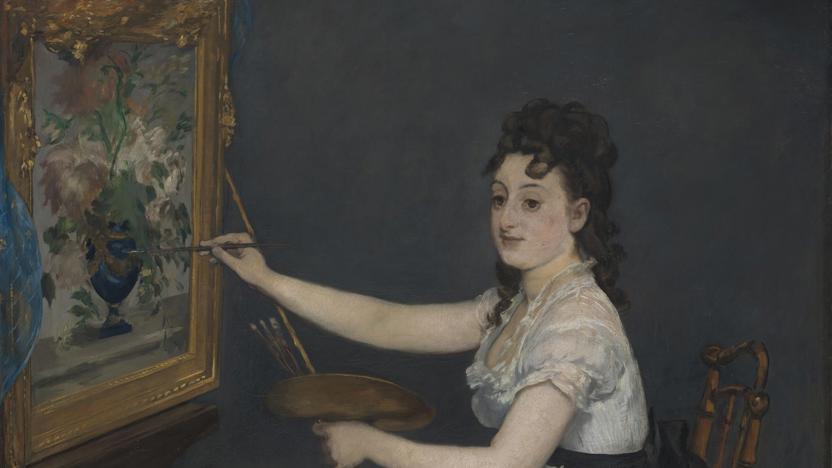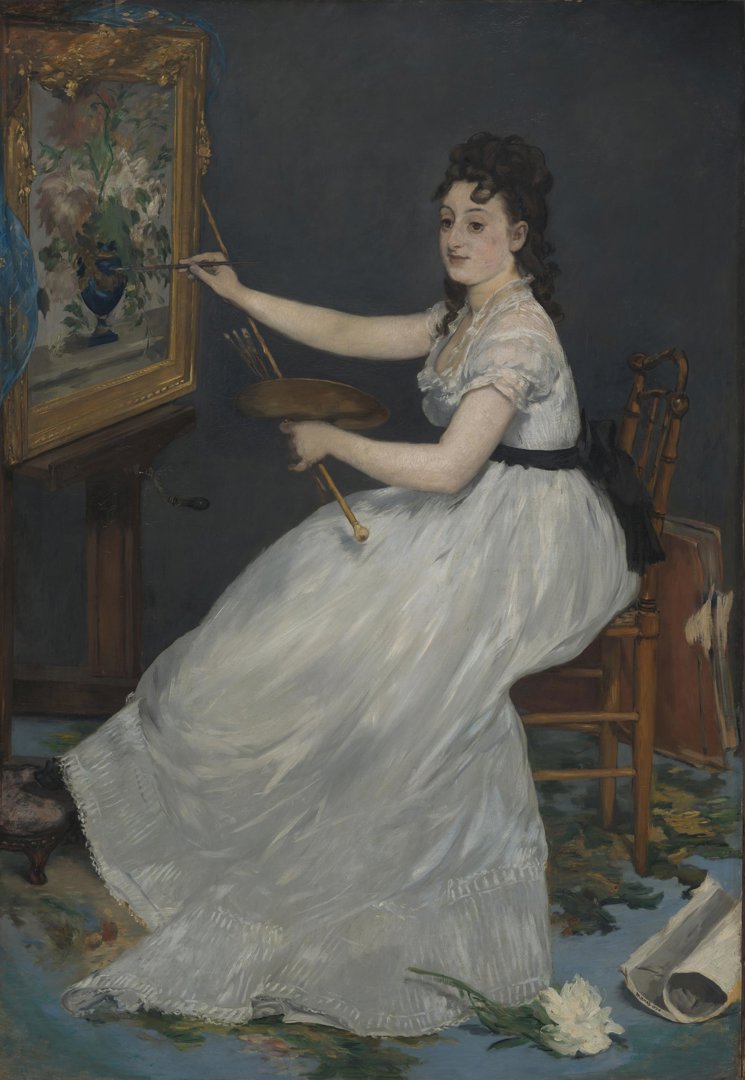Edouard Manet's 'Eva Gonzalès'
Audio description
This is a description of a portrait of 'Eva Gonzales' by Eduard Manet, painted in 1870. It is oil on canvas and is almost 2 metres tall by 1.3 metres wide. It is in an ornate gold frame.
The portrait is set in an interior. The twenty-three year old artist Eva Gonzales is on the right, seated on a delicate brown wooden chair facing to the left. She is working on a painting in front of her, on a dark wooden easel, which fills most of the top left of the composition. She wears a sumptuous, floor-length, white muslin gown, with short sleeves, which stands out vividly against the dark wall behind her.
Her head is turned towards us, her large dark eyes, under delicately arched brows, look down, rather than engaging with us or her painting. Her thick black hair is piled on top of her head with locks falling a little way down her back and over her right shoulder. Two dark curls fall on either side of her pale forehead, echoing the black sash round her waist.
The skirt of her gown fills most of the bottom half of the composition, creating a strong diagonal. It appears white, but additional long and short brush-strokes of grey and pale blues, as well as grey-pinks convey the translucent layers of material. The short sleeves are semi-transparent, like the frill at the scooped neckline. White highlights at the bottom of the dress indicate a gauzy hem, where the tips of her shoes rest on a small, tapestry footstool.
Eva holds a slender paintbrush in her right hand, her arm extended almost horizontally, as she holds it to the painting. In her left hand she has a circular wooden palette, along with three further brushes and a long mahl stick, that she might use to support her painting hand. The painting in front of her is already mounted in a gold frame. It depicts pink and white flowers in a dark blue vase. A bright blue gauzy scarf is draped over the painting’s top right corner and billows over the frame to the left.
The carpet under her chair is a soft blue pattern in greens and golds. The shapes suggest that it is floral but Manet has brushed them in broadly, almost as an abstract pattern. Leaning against the back of the chair to the right, is a large brown Portfolio. White smudges suggest protruding drawings. Cut off by the bottom right edge of the composition is a small, partially rolled canvas that has Manet’s signature, and the date. A little to the left of that, is a single large white flower with fluffy petals and green leaves. It lies on the carpet by the hem of Eva’s dress.
The colour scheme is typical of Manet’s painting of this period with muted tones of rich browns, blacks, greys and whites. These make the blues of the carpet, scarf and painted vase sing out. His technique was regarded as strident by conservative critics with its textured brush marks, bold outlines and strong contrasts of dark and light.
Eva Gonzales was Manet’s only formal pupil and the setting is his Parisian home. To modern eyes it might seem that Manet is presenting her as a beautiful amateur, dabbing at an already framed painting she is not even looking at. She is surrounded by floral imagery often associated with femininity. But more recent commentators have pointed out that professional women artists of the time, painted themselves in their finery to indicate their hard won success and status. The painting on the easel has been identified as a print of an 18th Century work, not her own painting at all, but which would imply her familiarity with the art from that period.


